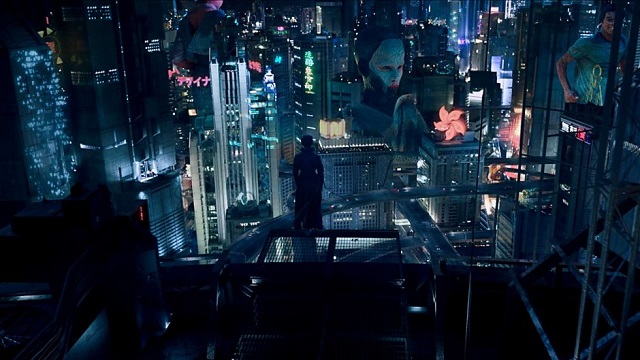I have never seen Ghost in the Shell. I’ve seen the movies that inspired it. I’ve seen movies and anime that were inspired by it (I mean, who hasn’t seen The Matrix). But, I’ve never seen any of the versions of Ghost in the Shell nor read its manga. So, with that said…
This adaptation of Ghost in the Shell is straight out of the 1990s. How 1990s is it, Julius? It’s so 1990s that I heard somebody blasting Beastie Boys’ Sabotage on my way to viewing it. Visually speaking, Rupert Sanders is adheres so closely to the visual style of the original art that he doesn’t put much of a modern spin on things. This looks like it was the next step of science fiction after Brazil and Blade Runner. The ghettos have a junky grunge aesthetic with wires hanging out all over the place. The cities have gigantic advertisements that tower over the buildings. People have cybernetic implants installed on their body, leaving exposed ports and tell tale LEDs all over the place. The original Ghost in the Shell was so thoroughly plundered for its visual style that the remake, for all its visual acumen, almost feels retro.
That said, the story of Ghost in the Shell feels like it’s been Americanized. In the near-distant future, Hanka Robotics is conducting top secret experiments to meld a human brain with a cybernetic shell, culminating in the successful creation of Mira Killian (Scarlett Johannson). A year later, Major Killian, now a ranked officer working for the government anti-cyberterrorist group Section 9, is hunting for Kuze, a cyberterrorist who hacks into people’s minds through various ports and backdoors. But, Kuze is looking for information about who he is and was, holding information that will disrupt Major Killian’s operation.
This version of the story is the intersection of Robocop, The Matrix and Dollhouse, pondering the idea of identity during a time of viruses, hacking, and government corruption (Ehren Kruger of Arlington Road and Transformers: Revenge of the Fallen is one of three credited screenwriters). Here, the ghost is the original personality left imprinted on the brain, creating glitches in the personality. But, who are you if your personality and memories have been replaced? What does it mean to exist if everything you know can be erased with a simple hack? They’re heady topics hacked to shreds with Ehren Kruger’s typical government paranoia and callbacks to other movies. There’s even a scene where Major Killian goes into a warm retro kitchen to meet an elderly woman who will reveal the truth over a cup of tea.
Of course, there’s also the issue of whitewashing, which amounts to “white is the default setting on government shells.” Which, bleh. I mean, yeah, sure, this is ScarJo’s default setting: the pretty girl who is only a shell of a human with her real personality hidden far deep inside. Why give her a straight black Japanese wig? It’s all because Rupert Sanders wanted visual fidelity to the original movie which had a pale white-looking girl with blue eyes.
For all its simplicity and stupidity and whitewashing, boy is Ghost in the Shell pretty to look at. Watching people dissolve is everything. The technology is almost caught up to anime levels of hyperreality. If you just want something pretty to look at, Ghost in the Shell will provide you with a happy 2 hours. Otherwise, Ghost in the Shell is a fairly dumb movie and you’d be better off rewatching Dollhouse (especially the Epitaph episodes).

